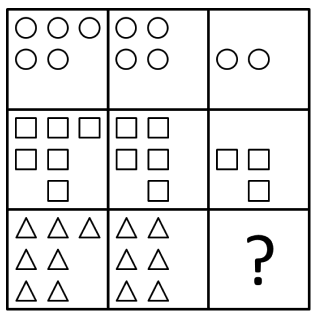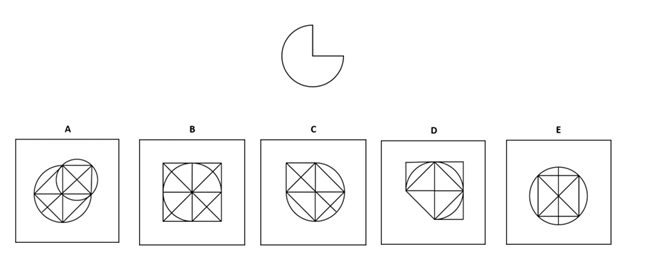Take our FREE online CAT 4 Level D Sample Test!
This sample test is designed according to the specifications of the CAT4 test for Year 7 in the UK. It contains questions of each of the various CAT 4 Level D question types, which are accompanied by useful solving tips and thorough explanations. All of this combines to give you a glimpse of the actual test.
Sample Test Preview
Verbal Reasoning Battery
This battery contains two tests: Verbal Classification and Verbal Analogies
In order to solve Verbal Analogy questions, you need to define the relationship between the first pair of words. The best way to do so is to form a sentence that describes the relationship.
Student Tip:
In order to solve Verbal Analogy questions, you need to define the relationship between the first pair of words. The best way to do so is to form a sentence that describes the relationship.
Then, look for a word from the answer choices that has a similar relationship to the third word you just defined. If the sentence you formed accurately describes the relationship of the new pair, you have found a potential answer. If none of the answer choices fit, or if multiple answer choices relate to the third word in this way, you may have to adjust your sentence or think of a new one to include or exclude some of the potential answers.
The following example is a Verbal Classification question. Choose the word that best fits with the given group of words
Quantitative Reasoning Battery
This battery includes two tests: Number Analogies and Number Series
The following example is a Number Series question. Number Series questions provide a series of numbers with a certain pattern or rule. You need to determine the pattern and use the rule to determine which number will come next in the series.
Student Tip:
To solve Number Series questions, you should start by thinking of a rule that describes the pattern in the set of numbers. For example, each number is greater than the previous number by 1.
Use the rule to determine which number will come next in the series. Then, look for the number you reached in the answer choices.
Sometimes patterns can be comprised of more than one rule. If a simple rule does not work, try out more complicated patterns. For example, the pattern may be to alternate between adding and subtracting specific numbers.
The following example is a Number analogy question. Choose the number that completes the third pair so that it demonstrates the same relationship as the first two pairs.
Non-Verbal Reasoning Battery
This battery consists of two tests: Figure Classification and Figure Matrices
The following example is a Figure Matrix question. Figure Matrix questions are either 2x2 or 3x3 matrices, comprised of different pictures. From the beginning to the end of each row and column, the pictures change in the same way or follow the same rule. You must choose an answer choice that goes in the empty box in the matrix that follows the same rule.
Student Tip:
To solve Figure Matrices questions, examine how the series of shapes change across the rows and down the columns within the matrix. The direction in which you examine the question depends on where you can most easily visualize the relationship.
Test the relationship rule on each answer choice and eliminate answers that do not fit. If more than one answer choice fits the rule, look for a more accurate rule. Remember that sometimes, there can be more than one applicable rule.
The following example is a Figure Classification question. Choose the answer which shares the same connection/characteristic as the three given images.
Spatial Ability Reasoning Battery
This battery includes two tests: Figure Analysis and Figure Recognition
The following example is a Figure Analysis question. Figure Analysis questions show a paper folded several times and then punched with holes. The answer choices contain unfolded papers with punched-in holes. You need to determine which of the answer choices is the final product of the unfolded punched-in paper.
The following example is a Figure Classification question. Choose the answer choice that contains the given shape. The shape must keep its size and orientation.
Student Tip:
To solve Paper Folding questions, start by eliminating answer choices that do not contain the original holes shown in the question.
Next, determine the number of holes that should be on the unfolded paper. For example, if the paper was folded once into two layers, each hole will go through both layers so there should be twice the number of holes. Remember that each folding of the paper doubles the number of layers that are being folded (and does not just add one layer as in the first folding). However, pay attention to which part of the paper is being folded. If the first fold does not cover the whole paper, and the second fold does not overlap with the first fold, there is no reason to multiply the layers twice.
Folding of the paper creates a symmetry line, meaning that punching holes in a folded paper make a mirror image along that line (after unfolding). Therefore, try to imagine how the holes will be reflected on the other side of the paper each time it is unfolded. Each hole will be the same distance away from the crease as its counterpart, but in the opposite direction, in a straight line that crosses the line of symmetry at a right angle.
When confused, you can always draw the problem on a square sheet of paper.
Need Additional Practice?
TestPrep-Online offers an accurate CAT4 Level D Practice Pack, featuring a comprehensive study guide and hundreds of practice questions, as well as thorough explanations and solving tips.








